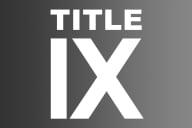You have /5 articles left.
Sign up for a free account or log in.
Perhaps we brought it on ourselves -- colleges and universities that “charge too much” and “sell coveted spaces to the highest bidder.” At least that is the image the public has developed of higher education. But we certainly did not get to this without a lot of help from the federal government to create demand by providing a relatively small -- but essential -- amount of financial aid funding (compared to what private colleges themselves provide for access), piling on regulations that accompany that funding and then restricting collegial collaboration through the early '90s investigation that ended the sharing of financial aid data among overlap schools.
In their latest solution in search of a problem, the Justice Department is picking on the National Association for College Admission Counseling and their Code of Ethics and Professional Practice that has, over the years, brought at least some order to a very stressful process for students and their parents. Colleges that seek to be members in good standing of NACAC must agree to certain principles. These have worked well for my entire career, helping students find the right college at the right price without, for the most part, sending parents and their children over the edge. I just retired last spring after 45 years in and around college admissions, serving institutions and students. The ethical guidance provided through the NACAC code helps colleges and students alike. I have my experience to draw on for that assertion, but it appears that the Justice Department knows better.
If the Justice Department prevails, and it certainly looks like it will, NACAC would remove the following from its code:
- "Colleges must not offer incentives exclusive to students applying or admitted under an early decision application plan. Examples of incentives include the promise of special housing, enhanced financial aid packages, and special scholarships for early decision admits. Colleges may, however, disclose how admission rates for early decision differ from those for other admission plans."
- "College choices should be informed, well-considered, and free from coercion. Students require a reasonable amount of time to identify their college choices; complete applications for admission, financial aid, and scholarships; and decide which offer of admission to accept. Once students have committed themselves to a college, other colleges must respect that choice and cease recruiting them."
- "Colleges will not knowingly recruit or offer enrollment incentives to students who are already enrolled, registered, have declared their intent, or submitted contractual deposits to other institutions. May 1 is the point at which commitments to enroll become final, and colleges must respect that. The recognized exceptions are when students are admitted from a wait list, students initiate inquiries themselves, or cooperation is sought by institutions that provide transfer programs."
- "Colleges must not solicit transfer applications from a previous year’s applicant or prospect pool unless the students have themselves initiated a transfer inquiry or the college has verified prior to contacting the students that they are either enrolled at a college that allows transfer recruitment from other colleges or are not currently enrolled in a college."
The Justice Department claims that removing these alleged “restraint of trade” statements will lower the price for students.
Our experience with federal mandates suggests just the opposite. Everyone talks about how college costs have increased significantly -- tuition at private colleges increased 98.5 percent from 1990 to 2018 in 2018 dollars. While the actual tuition price families pay went up “only” 17.9 percent, thanks in large part to increasing institutional financial aid (College Board, "Trends in College Pricing, 2019"), the actual cost for colleges to educate a student did increase significantly during this time, and some of these costs are naturally passed on to students.
Increases in cost are certainly related to other rising prices such as technology, construction and competitive salaries. They are also due to direct government requirements -- a proliferation of regulations which in many cases require additional staff in order to comply, the skyrocketing price of health-care benefits, and the bidding wars between institutions that increased in earnest over 25 years ago when the Justice Department investigation ended the practice of sharing need-based financial aid information among overlap colleges. This data sharing was originally initiated not to shortchange students, but to make sure that each institution had the same information about family financial strength in order to help students select the right college for them based on the best program -- not on the “cheapest choice.”
Competition for students in higher education is unlike a private (nonservice) business that, assuming demand, can increase volume to compensate for per capita revenue declines. When competition increases for colleges and universities, prices increase. Unlike car dealerships that might outdiscount a competitor to gain a sale while still making as profit, colleges are not only discounting those who could pay more in order to “win” the enrollment, they are also meeting the financial needs of those who cannot afford the full price. And in private colleges, the bulk of that need-based money comes from the institution itself. Sales of goods in the private sector only give the equivalent of “merit” money. Colleges also do that, and they fill the gap between price and ability to pay with institutional grant funds for needy students.
Another major difference is that the list price charged by most colleges and universities does not cover the cost, unlike private businesses where the cost of a product is inflated for profit. When discounted, the profit, albeit smaller, is still earned. Not so with colleges and universities. The difference between list price and cost is covered by annual gifts, endowments and other sources of revenue -- all of this before scholarships and need-based grants are applied to a student’s account.
The bottom line, especially for stand-alone undergraduate colleges with limited sources of revenue (no hospitals, big-time athletics or major research grants) is that someone has to pay. With the removal of these ethical code guidelines, colleges that are underenrolled will be able to recruit students after May 1 (or at any time, really) by simply saying, “We’ll beat any offer.” Individual students may benefit from that in the short run, but in the long run, with less per capita revenue and little opportunity to increase enrollment in this declining market, colleges will need to increase their list price in order to cover costs. Then, even when discounted, everyone will pay more. Of course, another option is to decrease costs, but unless there is a lot of fat to trim (and there typically is not in small colleges), cutting expenses generally means impacting quality. So one may be paying less, but one will actually be getting less.
When students select a college based on the best price, an unintended consequence is often a mismatch -- for example, the student is not challenged academically and decides to transfer. This adds to the systemic cost of the admissions process, and both student and institution lose.
My crystal ball is no better than that of anyone else who has been around for a while. Even if the NACAC membership votes to strike these principles from the statement, many (if not most) colleges will still adhere to the ethics behind them, at least in the short term. For example, it is certainly OK to recruit students after May 1 if they have not informed the recruiting institution of their plans, but if they have withdrawn their application and have decided on another choice, it is really not fair to the student or to the other institution to persist.
I believe we are likely to see a significant increase in the amount of the nonrefundable enrollment deposit that must be submitted. It might be easy to walk away from a $500 deposit, but not so easy to lose a $5,000 deposit.
I hope we do not see institutions requiring an early deposit before all admissions decisions and aid packages are known to students. I believe our friends in the Justice Department would frown on this in combination with a large nonrefundable deposit, because it would force students to make a decision before they knew all of their options. That is why May 1 needs to stay as the common candidate reply date. Or perhaps Justice did not think of this consequence?
The fact that it is OK for major league sports to be exempt from antitrust laws but that nonprofit higher education, in serving the public good, must adhere strictly to them is a conundrum that has baffled me for almost 20 years.
This is just the latest round of the new normal, I suppose. I loved my career in higher education that spanned five decades, and if I had to do it over again, I would. But I’d be less than honest if I didn’t say that retirement came at the right time for me. I’ll watch from the sidelines, rant a bit and shake my head, but I will continue to be grateful for the opportunity to have done the work we do every day that helps so many young people find their way in life. That, and not all of this extraneous maneuvering for the sake of rattling the cage, is what education is all about!








